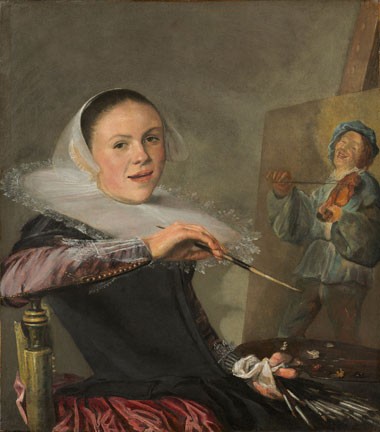Judith Leyster was one of two women to be a member of the Haarlem Guild of St.Luke and the only women who became a Master Painter in the period known as the Dutch Golden Age, she was brought to my attention by Amanda Vickery in a television series called Women in Art. Women painters are far fewer in number than male painters and there are several reasons for this, often the question is posed ‘Why are there no great female painters’ I would like to put forward one or two theories of why this is so and ask if you have others. Firstly in the past young men joined art studios and art schools as apprentices, it was not considered fitting for women to do so, students learnt the necessary skills over many years, while most young women were expected to marry and raise a family, needlework such as making samplers or doing embroidery was acceptable and being skilled at drawing botanical illustrations was a popular pursuit also amateur artists and young people from wealthy backgrounds were able to undertake lessons from a tutor at home. There were a few voices who commented on the place of women such as John Stuart Mill who wrote ‘ The subjection of women to me, being a universal custom, any departure from it quite naturally appears unnatural.’ And so we see artists traditionally trained in the studio system and it was male dominated, gallery owners also denied women a space to exhibit.
Secondly, a popular view was that a ‘divine creator’ provided the creativity and imagination required in a literal way, I think many considered such inspiration to be a male phenomena, although there are exceptions such as reclusive nuns who often reached heights of the sublime. The artist who was a misfit or social outcast was also seen as special, these reasons may well have been a factor driving the person onward, if we study a Van Gough painting for example, we find an intensity, an energy. Thirdly, without doubt it is very difficult to combine being a mother who provides her children with emotional and physical security with being a dedicated painter or any art form, compromises will need to be made, a middle way sought. Women cannot be equal in all ways, physically is an example, we are not as strong and we bear the offspring, but what women would like is the freedom to make informed choices and we are fortunate to live in a society that is on the whole equal. I do not know why Judith Leyster painted very little after the birth of their five children, she will have grieved for those who did not survive, perhaps it was a conscious decision or ill health may have been the cause, she died in her fifties.
Lastly there is this idea of the artist as being a ‘genius’ but few men or women are born geniuses, I know I have been heard to say he/she is a genius when I mean someone extra talented, and there are child prodigies of course. A certain kind of intelligent curiousity is required, it is usually an incremental process, encouragement from the artist’s family may have an influence also there is a saying ‘it’s in the genes’referring to shared family traits, I do not know what truth there is in the statement, if artistic creativity surrounds the young person it may well leave an impression, some succeed in spite of opposition.
Judith Leyster was the eighth child in the family, her father was a brewer and cloth maker until he ventured into a coffee house business which made him bankrupt, Judith may have sold paintings to help the family finances, The family moved to Utrecht where Judith Leyster set up a studio in 1633 where she employed three male apprentices, unusual for the time, that is when this self portrait was painted, she married a painter, Jan Miense Molenier in 1636. Judith gave up painting after her children were born except for two known works, an illustration for a book about tulips, published in 1643 and a portrait in 1652. The painting above painted in 1633 ensured her reputation, she may have been a student of Hals, her work has certain qualities that he had but she was not an imitator of his work. A self portrait is revealing, it gives identity as an artist, here we see her holding the paint brush, it is not set aside on a table, we see she is working, she paints in the Dutch tradition, she had no wish to be controversial, her head is turned away from the easle, her subjects were often musicians, she meets our gaze, it is a proud look, not provocative though, she is dressed in the fine clothes of the Dutch middle class to symbolically show us her social and economic status, – a painter would usually wear a smock, her pose is informal, she is at ease, the arm holding the paint brush rests on the arm of the chair, she seems relaxed, confident.
The use of paint among professional artists is on the decline, that may change, many women and men with time on their hands paint for pleasure, it is not hard to find art classes in many locations around the country for them to join.
The image is from Wikipedia Commons.

